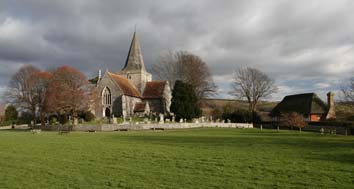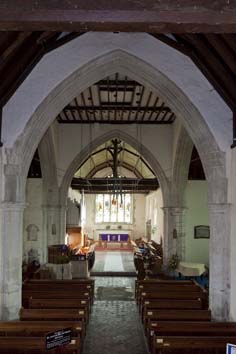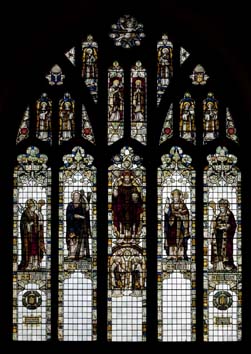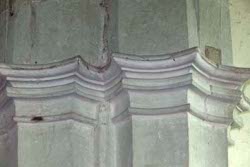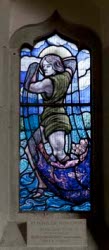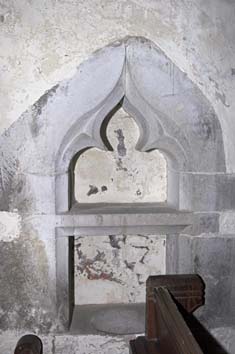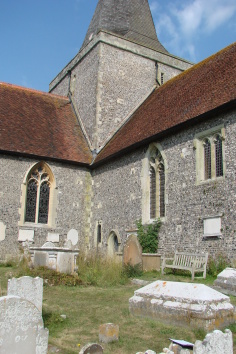Alfriston – St Andrew
A large mid- to late C14 cruciform church with a central tower. There is both curvilinear and panelled tracery and the sedilia and some glass are contemporary.
Alfriston, today a famous beauty spot, was in the Middle Ages the largest place on the lower Cuckmere and the highest point ships could reach (1 p99). The church is east of the main street elevated above the Tye, a broad grassy area where there may have been a market. South of the church is a rare survival, the C14 parsonage, which was the first building acquired by the National Trust in 1896. The tiebeam and crownpost roof of the hall recalls that of the church.
Godfrey thought the round churchyard, sloping up to the church, was evidence of an early origin (3 p1). It is thus paradoxical that the whole church is in fact mid to late C14, unusually late in Sussex. and there is no evidence of an earlier church, though there must surely have been one. It follows that the reason for a rebuilding is not apparent, though it was complete by 1399, when the advowson is said to have been acquired by Michelham priory (Meads). Like other churches of the period, e g the smaller and slightly later Poynings, West Sussex, the plan is cruciform and aisleless. At Alfriston, nave and chancel are the same length with slightly shorter transepts. The material is well knapped and laid flint, with a band of sandstone ashlar above the plinth. Putlog holes left over from the scaffolding are visible in the tower. The windows vary between panelled tracery and the type of curvilinear tracery, known for obvious reasons as leaf tracery.
Both are found throughout, arranged symmetrically, showing that they were in use at the same time and, indeed, the west window combines them. Its otherwise straight mullions are interrupted towards the top by irregularly shaped curved pieces. There is only one fairly small window each side except in the chancel and the west walls of the transepts have none, so the interior is dark. The west end was usually built last, yet the west window and the rather larger east one are not greatly different, suggesting the whole was built in a short time.
The concern for symmetry extends to the sides of the chancel, each of which has a window with leaf-tracery and an ogee-headed lowside (the sill of the one to the north is rather higher). According to Meads, only Fletching amongst East Sussex churches otherwise has a lowside on both sides. The only irregularities are on the south side, where there are a square-headed window set high and a moulded priest’s doorway. The nave doorways are similar (the north one is blocked), but the west doorway has a square hood-mould and traceried spandrels. The broad crossing arches have semi-octagonal, concave responds and moulded heads that emerge from upward extensions of the capitals. Hussey (p184) claims to have seen similar arches in Kent but gives no details. The squat tower has small square openings, a plain parapet and a shingled broach spire. The tiebeams and crownposts of the roof are original except in the south transept. Unusually, they are said to be of chestnut wood (Langdon p232) and the easternmost one in the chancel retains a rare survival, the hooks and staples from which the Lenten veil was hung (Mitchell/Shell Guide p52).
The south porch is not bonded in to the main structure, but the continuous moulded arch is no later than the rest. Nothing more was done before the Reformation and the drawing in the Sharpe Collection (undated, but most churches in the district were sketched in 1803-04), shows little change since.
There were six stages to the C19 restoration (CDK 1877 pt 2 p83), starting in 1875 with the south transept, for which H E Rumble was responsible (B 29 p545). In the next year he restored the chancel (ibid 31 p349) and the north transept was also done (ICBS). More cavalier than his successors, he replaced the roof and the external stonework in the south transept, but some old stonework remains in the north one. In the chancel, he renewed the east window without significant change, but did not do anything to the side ones. The rest was more carefully treated. L W Ridge worked on the nave in 1888 (CDK 1888 pt 2 p140), when £600 was spent and the roof was opened up – he was presumably responsible for the boarding between the rafters, which contributes to the general darkness. He also installed open-topped vestries either side of the west doorway. The main work after this was in 1905 to the tower, as so often probably done last and the work included repairs to the spire as well (3 p2).
In 1995 the west vestries were enlarged with a gallery area over them to the design of R Crook of J D Clarke and Partners (3 p4). The design incorporates older timber and glass; the lower parts are C19 in origin but the rail of the gallery resembles that round the adjacent war memorial (see below), which may be taken from the C17 altar rails. Subsequently, in 1999 the south porch was extended to provide cooking and toilet facilities (ibid).
Fittings and monuments
Altar rails: Part of the early C17 altar rails have been re-used as the surround to the war memorial.
Choir stalls: c1905 by Wratten and W H Godfrey (BE(E) p91).
Easter Sepulchre: (North side of chancel) Like the sedilia (see below) this has a concave gable with shafts. The figures on the chest are from the former reredos (see below) (3 p8).
Font: Square C14 bowl with a chamfered underside, into which capitals have been carved at the corners. The later base has an octagonal shaft at each corner. It is one of a number of this type in the area, though plainer (see Eastbourne – St Mary, Church Street and Willingdon).
Glass:
1. (North transept north and east windows) The head of the north window contains C14 work, including two saints, one thought to be St Alphege (Mee p12). The remainder of both windows formerly contained glass by E R Frampton senior, c1876-77 (www.stainedglassrecords.org, retrieved on 28/1/2013).
2. (East window) J Powell and Sons and designed by C E Powell, 1904 (CDG 126 p73). F Mann and —- Read were also involved (D Hadley list), presumably on the technical side. The design consists of figures set in largely plain glass.
3. (South transept south and east windows) Kempe and Co, 1914. It consists of groupings of figures set in clear quarries, an unusual design for the company at this time.
4. (Chancel south lowside window) M Balfour, 1902 (St Christopher, Crewe Beynon) (Information from Jennifer Cross, citing Balfour’s grand-daughter, Anita Hooper). This was formerly attributed to H Goodall (www.stainedglassrecords.org, retrieved on 28/1/2013), but the attribution to Balfour is the better documented.
5. (Chancel north lowside window) J A Nuttgens, 2004 (St Peter) (2 p19).
Mass dial: South west corner of the porch.
Painting: There is a painted consecration cross north of the altar and vestiges of wall-paintings were found in 1887, but were not preserved (3 p4).
Piscinae:
1. (Both transepts in the east walls) C14 ogee-headed, divided by ledges.
2. (Chancel south side) Closely related to the sedilia (see below).
Reredos: (formerly) Large stone C19, probably dating from the 1876 restoration. It was removed in 1987 (3 p6).
Royal Arms: (North nave) Painted arms of George I dated 1725.
Sedilia: (Chancel south side) C14 triple with unusual round-headed arches on octagonal shafts. Above each a concave gablet breaks the otherwise level top and terminates in a carved finial. It is related to the adjacent piscina and the Easter sepulchre opposite (see above), carved in a style more vigorous than delicate. Hussey (ibid) suggests that these are all earlier work reset, but in every respect except the round heads they are characteristic of the later C14. There was something of a revival of the round head at this date for non-structural purposes – see for example the rere-arch of a doorway in the chancel at Wadhurst.
Sources
1. H Clarke and P E Leach: The Mediaeval Churches of the Cuckmere Valley, SAC 123 (1985) pp 95-108
2. F Fox-Wilson: A Guide to St Andrew’s Church, Alfriston, 2nd edition, 2006
3. W H Godfrey: Guide to the Church of St Andrew, Alfriston (with Lullington) (Sussex Churches no 5 1930)
4. : St Andrew, Alfriston, SNQ 3 (Feb 1930) pp11-12
Plan
1. Measured plan in 1. p100
2. Measured plan by W H Godfrey (?) in 3. inside cover
My thanks to Nick Wiseman for the photographs except those of the south side of the chancel and the west end
